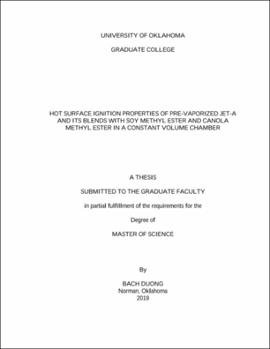| dc.description.abstract | In recent years, biofuels have emerged as an attractive alternative to traditional petroleum fuels due to their renewable and almost carbon-neutral nature. While the fundamental ignition properties of petroleum fuels are well understood, knowledge of ignition properties of biofuels and their blends with petroleum fuels is limited. Studies of the fundamental ignition properties of biofuels are important for the safety of storage and transportation of these fuels. The objective of this study was to compare the relative hot surface ignition properties of biofuel blends at different equivalence ratios in a constant-volume chamber. Properties that were measured in this study are: ignition energy, time interval for ignition, ignition surface temperature, and flame front velocities. The fuels studied were blends of Jet A (petroleum fuel), Soy Methyl Ester, and Canola Methyl Ester (biofuel) over an equivalence ratio range of 0.75-2.0. A commercially available silicon carbide dryer ignitor was used as the ignition source and was located in the center of the combustion chamber. A high-speed camera recorded the propagation of the flame following ignition, allowing for the calculation of the flame front velocity. K-type thermocouples measured the temperature of the mixture at selected points inside the combustion chamber.
The flames produced by the blends propagated quickly and were brightest at equivalence ratios of 1.3 – 1.5. For all the blends, the power supplied to the ignitor increased gradually and became stagnant as it approached the ignition point. It was also found that the time interval for ignition decreased with increasing equivalence ratio. Ignition temperature of the air-fuel mixture was nearly constant for all fuels at about 650°C (923 K). Upper and lower flame velocity peaked at around 6.5 m/s and 3.2 m/s,respectively, at equivalence ratios of 1.3 – 1.5. In general, ignition properties of biofuel blends were comparable to those of their pure fuels. | en_US |
